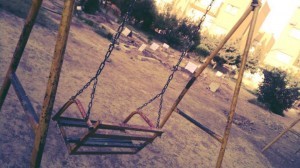Parks Become Cemeteries in Deir El-Zor

By Nashwan Marzouk
The rusty swing looks almost as if it is still moving, even though there is no one nearby. In a far corner, freshly-dug out graves are visible. This is a photo published on journalist Lina al-Joudi’s Facebook account, and it shows one of the many public parks that have been turned into cemeteries in the city of Deir El-Zor in the east of Syria.
“The people of Deir El-Zor have been burying their dead at night in the parks… for the past 45 days,” says Ziad Awwad, a member of the Local Coordination Committee in the city. “There was a cemetery for martyrs of the revolution where the first martyr Maath al-Rakkad… was interred. Burials in that cemetery continued until the military campaign against the city became intense.”
Al-Nassara, Al-Mashtal and Al-Hamidiyyeh are among the parks in Deir El-Zor that have been transformed from places of recreation into burial sites, where the victims of conflict are quickly placed in makeshift graves. Residents say shelling often prevents the customary funeral processions from taking place.
Awwad has witnessed a number of deaths himself. He recalls a man called Yasser al-Dakhul, who was standing by the garden of Al-Uthman Mosque, adjacent to his house. While he was looking in amazement at the many dead bodies lined up in the garden, a mortar shell landed and killed him. The yard in front of Dakhul’s house has now become a cemetery, like the mosque grounds.
Battles between regime forces and the Free Syrian Army, FSA, escalated in Deir El-Zor in May 2012. In August, the FSA reportedly captured the headquarters of the “hajjana” camel troops, and earlier the same month, opposition fighters said they had shot down a MiG-21 fighter plane.
The armed forces launched operations in Deir El-Zor in late July 2011, following a demonstration that gathered more than 300,000 protesters, according to the London-based Syrian Observatory for Human Rights. In August last year, pro-regime media aired footage of what they described as “terrorists” in the city killing a member of the security forces and maiming his body.
The military campaign to regain control of the city and surrounding areas does not just kill FSA fighters. According to an activist who runs a field hospital and spoke on condition of anonymity, air raids alone result in nearly ten deaths a day, both FSA members and civilians.
As the killing continues unabated, people in the city say they have to abandon some of the burial rites passed on from generation to generation.
In the Muslim tradition, the body is ceremoniously washed and shrouded in a white cloth, and then placed in a grave aligned towards the holy city of Mecca. The face of the deceased is uncovered before the grave is closed.
“Burial has lost its meaning and is no longer performed according to the customs,” activist Mohammad Jalal al-Ahmad said.” Now we have started to bury body parts in ditches, not graves.”
According to Ahmad, when a family of nine was killed in the village of Mhaimadiyyeh, people turned out for a funeral procession. As they were heading for the village cemetery, participants were hit by helicopter gunfire. Those killed in the attack had to be buried in a mass grave dug by a bulldozer.
There are no statistics on the number of bodies buried in public places, partly because there are no specialist human right activists in the city, but also because the priority is to offer relief to the wounded.
The bereaved now dream of having a proper marked grave for their loved ones which they could visit.
“The revolution shall overcome; I have seen it in my son’s eyes,” one mother said. “But I’m afraid that I won’t be able to locate his [grave] amid all this rubble. I want to put amaryllis flowers, which he loved, on his grave on the morning of every Eid holiday.”

